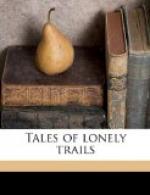The wind blew a warm gale all night. I lay awake a while and slept with very little covering. Toward dawn the gale died away. I was up at five-thirty. The morning broke fine, clear, balmy. A flare of pale gleaming light over the Funeral Range heralded the sunrise. The tips of the higher snow-capped Panamints were rose colored, and below them the slopes were red. The bulk of the range showed dark. All these features gradually brightened until the sun came up. How blazing and intense! The wind began to blow again. Under the cottonwoods with their rustling leaves, and green so soothing to the eye, it was very pleasant.
Beyond our camp stood green and pink thickets of tamarack, and some dark velvety green alfalfa fields, made possible by the spreading of Furnace Creek over the valley slope. A man lived there, and raised this alfalfa for the mules of the borax miners. He lived there alone and his was indeed a lonely, wonderful, and terrible life. At this season a few Shoshone Indians were camped near, helping him in his labors. This lone rancher’s name was Denton, and he turned out to be a brother of a Denton, hunter and guide, whom I had met in Lower California.
[Illustration: DESERT GRAVES]
[Illustration: THE GHASTLY SWEEP OF DEATH VALLEY]
Like all desert men, used to silence, Denton talked with difficulty, but the content of his speech made up for its brevity. He told us about the wanderers and prospectors he had rescued from death by starvation and thirst; he told us about the terrific noonday heat of summer; and about the incredible and horrible midnight furnace gales that swept down the valley. With the mercury at one hundred and twenty-five degrees at midnight, below the level of the sea, when these furnace blasts bore down upon him, it was just all he could do to live. No man could spend many summers there. As for white women—Death Valley was fatal to them. The Indians spent the summers up on the mountains. Denton said heat affected men differently. Those who were meat eaters or alcohol drinkers, could not survive. Perfect heart and lungs were necessary to stand the heat and density of atmosphere below sea level. He told of a man who had visited his cabin, and had left early in the day, vigorous and strong. A few hours later he was found near the oasis unable to walk, crawling on his hands and knees, dragging a full canteen of water. He never knew what ailed him. It might have been heat, for the thermometer registered one hundred and thirty-five, and it might have been poison gas. Another man, young, of heavy and powerful build, lost seventy pounds weight in less than two days, and was nearly dead when found. The heat of Death Valley quickly dried up blood, tissue, bone. Denton told of a prospector who started out at dawn strong and rational, to return at sunset so crazy that he had to be tied to keep him out of the water. To have drunk his fill then would have killed him! He had to be fed water by spoonful. Another wanderer came staggering into the oasis, blind, with horrible face, and black swollen tongue protruding. He could not make a sound. He also had to be roped, as if he were a mad steer.




